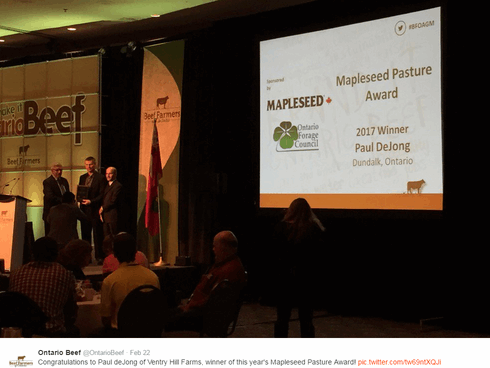Paul De Jong is recognized for his pasture management techniques
By Jennifer Jackson
Recently, an Ontario beef producer was recognized for his excellent pasture management efforts. Paul De Jong of Ventry Farms, a calf to finish organic beef operation in Dundalk, believes strongly in his strip grazing techniques for both pasture and herd health.
The Beef Farmers of Ontario (BFO) presented the 2017 Mapleseed Pasture Award to De Jong at its Annual General Meeting in Toronto on Feb. 22.
Ventry Farms is made up of 450 acres, including 100 acres of pasture and 30 acres of rented pasture land. De Jong manages 50 cow-calf pairs and 70 stockers that he pastures over the summer, according to a BFO Feb. 22 release.
De Jong strip grazes his cattle to boost productivity on his farm and lower feed costs.
Farms.com recently connected with De Jong about his farm operation and award.

Beef Farmers of Ontario Photo
Farms.com (Farms): Can you further discuss your pasture management practices?
Paul De Jong (PDJ): We rotationally graze the cattle into a new paddock every day. You don’t want them in the same paddock every day for (the sake of the) pasture regrowth. (We) manage the forage and not the beef – but (instead) use the beef to manage the forage.
If you use rotational grazing properly, you can have twice the grass production (that you would have conventionally) – this (approach) also means you can have twice as many cattle. (The cows) will have a more consistent feed and higher levels of gain – ours were actually a little on the fat side, the food was too good for them!
Farms: Why did you first practice strip grazing?
PDJ: (In addition to) environmental benefits, (strip grazing) improves farmers’ bottom line – there is a lower cost of production.
You can double (your) forage production, reduce or eliminate soil erosion and leaching, and it’s the best and fastest way to improve soil quality, quantity, structure, aggregation and soil biology.
Also, there is less labour costs. The more you can get your animals to eat out of the pasture, the less you have to use equipment. (This approach) also reduces the cost to make feed and the cost to spread the manure back out in the pasture. Even with those who feed the cattle in the field, you still have the cost of producing the feed.
Farms: How long have you been strip grazing?
PDJ: I was a dairy farmer until about a year and a half ago – so I have been strip grazing since the switch. When we were looking at switching to beef, we started from scratch and put in the proper infrastructure.
Farms: Is moving the cattle daily labour intensive?
PDJ: For me, it takes longer to walk to the field than it does to actually rotate the cattle. The actual moving only takes about ten minutes – we check on them every day anyways.
Farms: Do you have any advice for those considering more intensive pasture management?
PDJ: The infrastructure (and) pasture layout – the better the layout, the more likely you will stick to (strip grazing. When determining layout), consider (factors such as) animal movement, watering, handling, and trees for shelter from wind and sun.
The farmer should have good knowledge of what he/she can accomplish. (After) knowing your fencing (capabilities), you have to have knowledge in grass growth.
Farms: How does it feel to be recognized for your pasture management efforts?
PDJ: It (feels) nice to be recognized for your efforts. I always like to promote agriculture or try and teach other interested producers a different way. It’s always exciting to win.
Farms.com congratulates De Jong on his award!